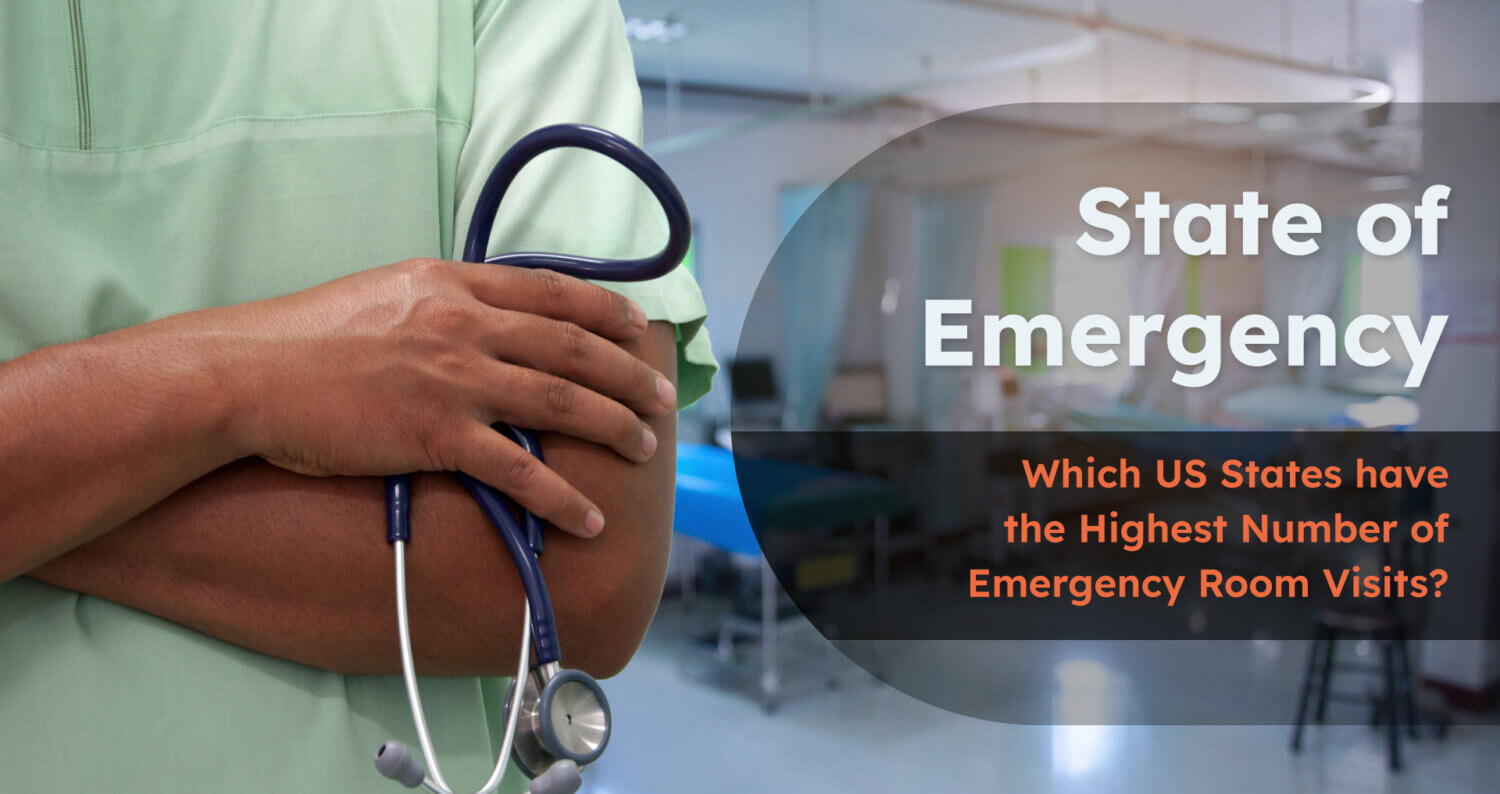State of Emergency
Table of contents
- Which US States have the Highest Number of Emergency Room Visits?
- States with the Most Emergency Room Visits
- States with the Fewest Emergency Room Visits
- The Most Common Illnesses for Emergency Room Visits in the US
- US Hospitals with the Most Emergency Room Visits, Ranked
- Top Tips for Injuries and Illnesses
Which US States have the Highest Number of Emergency Room Visits?
It has been reported that over 130 million Americans visit US emergency rooms each year. The ongoing effects of the COVID-19 pandemic have led to more and more state residents being treated in emergency rooms. Elderly people in particular have suffered from falling ill with the virus, which has caused a surge in hospital discharges.
Here at NiceRx, we felt it was important to address the increase in hospital visits in recent years within the US. The states that were hit the most by the COVID-19 virus tended to see a higher number of people visiting the emergency department, which has caused issues with waiting lists and resources.
In this report, we reveal the US states with the higher number of emergency room visits and the most common reasons for hospital discharges. We also explore which hospitals in the US had the most emergency room visits.
With emergency departments in high demand, we included expert tips on the injuries and illnesses which require emergency treatment and those that are less of a priority.
Before we commence the State of Emergency in the US, here at NiceRx, we work with your healthcare provider to help you access affordable medications directly from US pharmaceutical companies, including popular brand-name medications like Entresto.
States with the Most Emergency Room Visits
We will now explore the states with the highest number of emergency room visits. Our figures are based on medical data, which included all adults who are expected, payers. Most of the data is from 2020, and any states with no data available were removed.
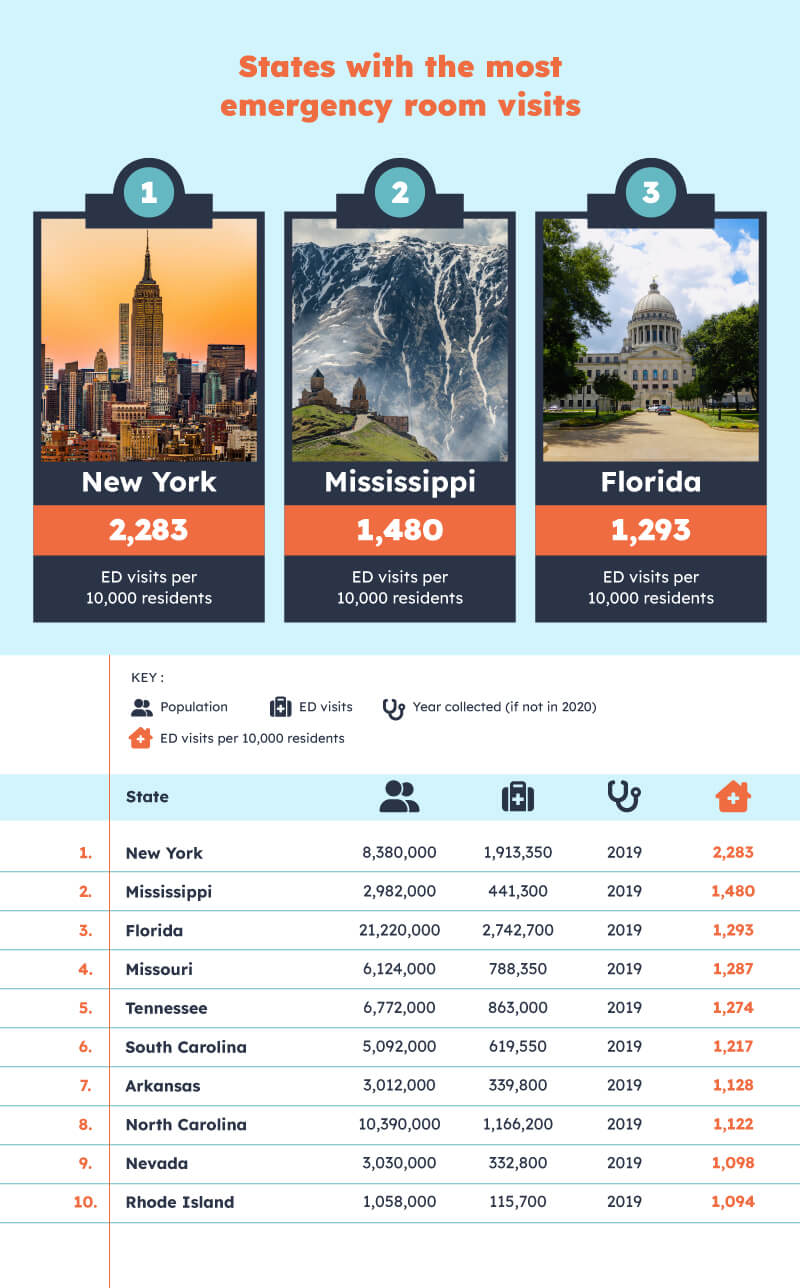
1. New York
ED Visits per 10,000 Residents: 2,283 visits
New York had the highest number of emergency room visits on our data set, with the figures collected from 2019. The state had a total of over 1.9 million visits in 2019, a total of 2,283 per 10,000 residents.
In New York state, over four million people make approximately seven million visits to hospital emergency departments that often do not result in a hospital stay. The primary reason for ED visits shows that many could have avoided a hospital stay, in a less costly or preventive care setting.
2. Mississippi
ED Visits per 10,000 Residents: 1,480 visits
Mississippi had the second-highest number of emergency room visits in 2020, with a total of 441,300 discharges. That’s a total of 1,480 visits per 10,000 residents.
Research revealed that rural Mississippians were more likely to use emergency rooms for COVID-19 visits than their urban counterparts, making up 64% of total ER visits in Mississippi during the 15-month period. It’s likely due to a lack of healthcare systems in the state’s remote areas.
3. Florida
ED Visits per 10,000 Residents: 1,293 visits
Florida had the third-highest number of emergency room visits in 2020, with a total of 2,742,700 discharges. That’s a total of 1,293 visits per 10,000 residents.
In 2020, it was found that the number of ER visits in Florida between March and April decreased by 42% compared to the previous year, according to the federal Centers for Disease Control and Prevention. However, the number of visits for infectious-disease screenings and exposures increased fourfold.
States with the Fewest Emergency Room Visits
We will now take a look at the states with the lowest emergency visit numbers in the US in the last quarter of 2020. We found that the states with the lowest numbers were geographically diverse and tended to be smaller state populations.
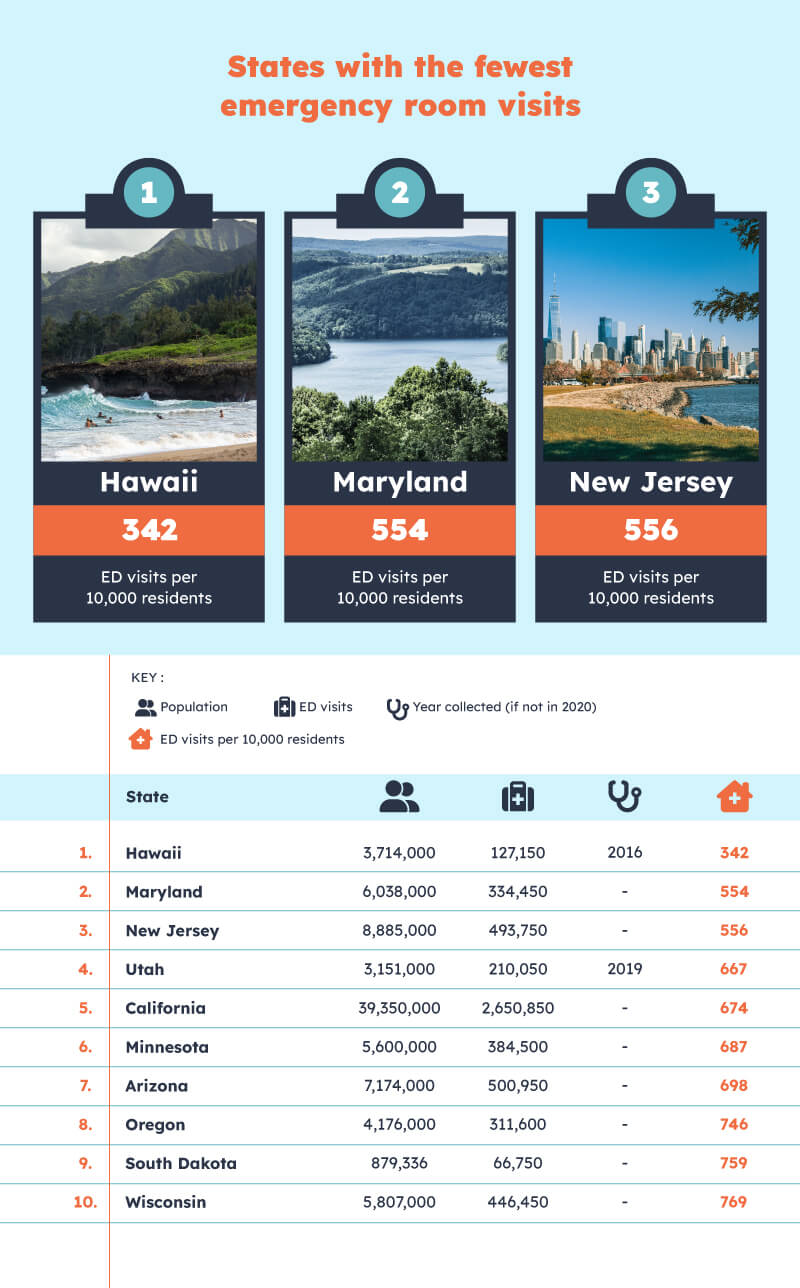
1. Hawaii
ED Visits per 10,000 Residents: 342 visits
Hawaii had by far the lowest emergency department visits out of all of our states. The data set, from 2016, showed that just 127,150 visits were recorded in quarter 4 of the year. That’s 342 visits per 10,000 Hawaii residents.
Just this year, it was reported that Mau’s private hospital had suffered from budget shortfalls, and the hospitals faced staff shortages. These issues have hampered hospital performance in the state, along with a series of cuts caused by the pandemic.
2. Maryland
ED Visits per 10,000 Residents: 554 visits
Maryland was the state with the second-lowest number of emergency department visits. The data from the last quarter of 2020 revealed that there were 334,450 emergency room visits, just 554 per 10,000 Maryland residents.
Maryland undertook an expanded testing and tracing scheme, increased hospital surge capacity, and ramped up its supply of PPE, as well as a robust contact tracing operation. The state managed to take early, aggressive measures to slow the spread of COVID-19.
3. New Jersey
ED Visits per 10,000 Residents: 556 visits
New Jersey was the state with the third lowest number of emergency department visits. The data from the last quarter of 2020 showed that there were a total of 493,750 discharges, just 556 visits per 10,000 New Jersey residents.
New Jersey’s Department of Health set the standard for the public to visit COVID-19 testing locations across the state, rather than visiting the emergency department. The state’s health commissioner relayed that emergency departments are only for those who need critical, life-saving care.
The Most Common Illnesses for Emergency Room Visits in the US
To further tackle the state of emergency in the US, we will now look into state-specific monthly emergency room patient stays related to COVID-19 and other conditions. This data is based on the December 2021 state inpatient databases (SID), however, some state data was collected for different dates (see the last table). Any states without relevant data were removed.
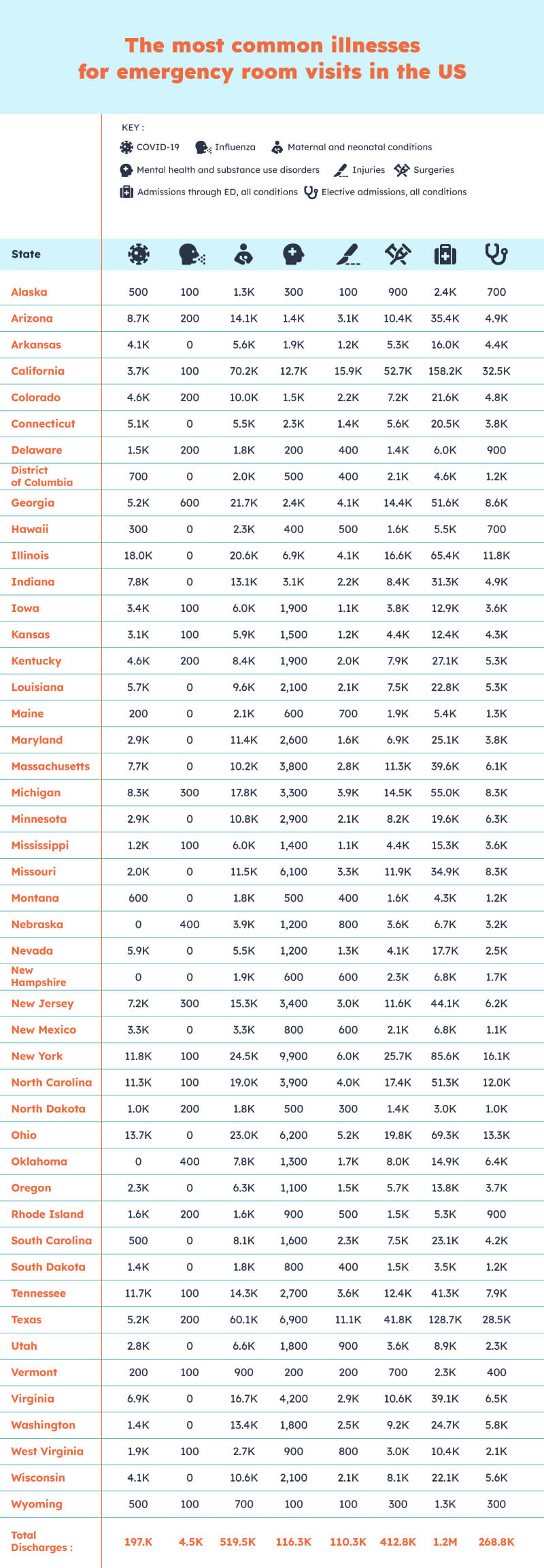
1. Maternal and Neonatal Conditions
Total Discharges: 519,500
The most common reason for patients visiting the emergency room in the last quarter of 2020 was for maternal and neonatal conditions, with a total of 519,500 discharges collected in December 2021.
The neonatal period is a vulnerable period of pediatric health. Emergencies typically occur during this period, although many emergency care visits are sometimes preventable with preventive hospital care in the newborn period. Patients visiting the ER with a non-emergency can lead to increased costs and loss of resources in healthcare.
2. Surgeries
Total Discharges: 412,800
Surgeries were the second most common reason for patients to visit the emergency room in the last quarter of 2020. In December 2021, there were a total of 412,800 hospital visits within the month.
The most common surgical emergencies which require an inpatient stay in the emergency room are acute appendicitis, bowel obstruction, gastrointestinal perforation, intestinal volvulus, acute mesenteric ischemia, peritonitis, and stercoral perforation.
3. COVID-19
Total Discharges: 197,500
The COVID-19 virus was the third most common illness for patients to visit the emergency room in the last quarter of 2020. There were a total of 197,500 monthly visits in the last quarter of 2020 in the US.
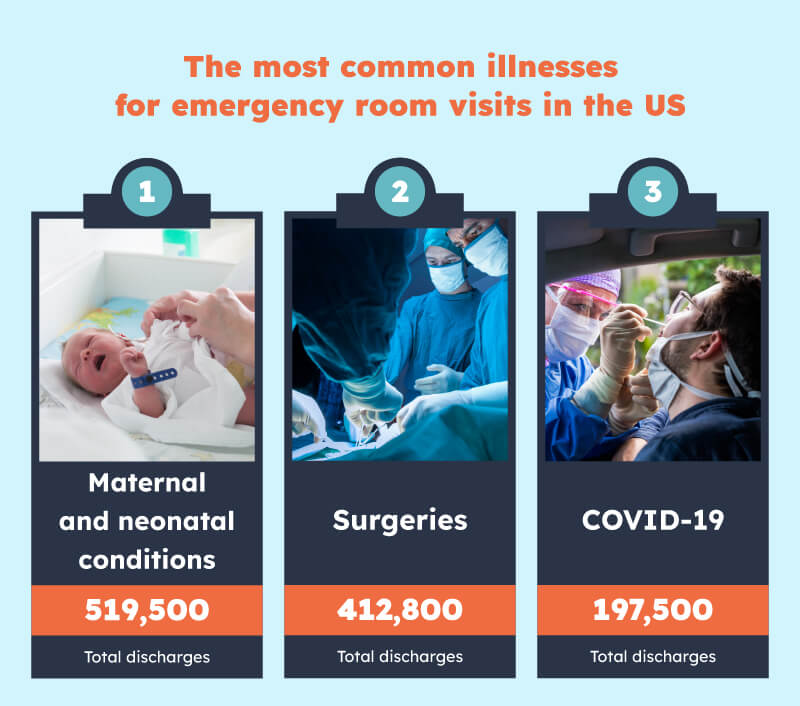
There was a significant decline in emergency room visits during the outbreak period of COVID-19. However, the number of emergency room visits remained stable during the pandemic and towards the end of 2021. Changes may have resulted from public fear of the virus and may be down to the delay of medical intervention.
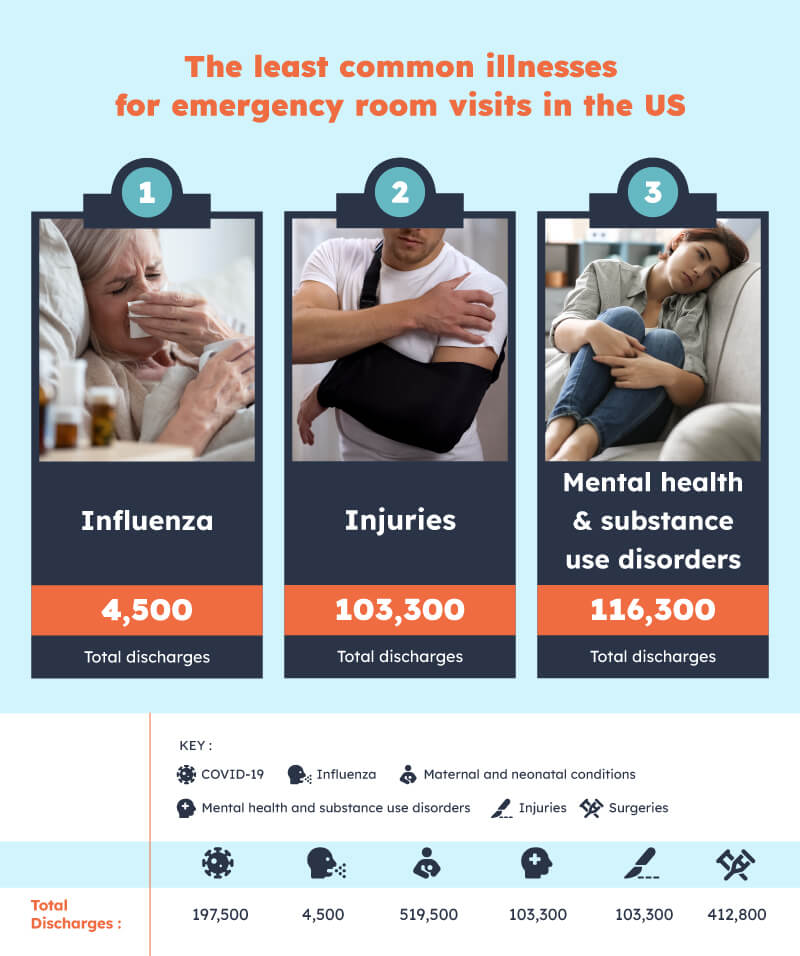
We will now look at the least common illnesses for emergency room visits in the US within the last quarter of 2021.
1. Influenza
Total Discharges: 4,500
Influenza was the least common illness for emergency room visits in the US within the last quarter of 2021. There were a total of just 4,500 visits recorded in December 2021 across the US.
More commonly known as the flu, influenza has become one of the main drivers of increased winter mortality. Seasonal influenza epidemic periods have been associated with an increase in emergency department visits across the country.
2. Injuries
Total Discharges: 103,300
Injuries were the second least common cause of emergency room visits in the US within the last quarter of 2021. There were a total of just 103,300 visits recorded in December 2021 across the US.
3. Mental Health and Substance Use Disorders
Total Discharges: 116,300
Mental health and substance use disorders were the third least common reason for emergency room visits in the US during the last quarter of 2021. There were a total of just 116,300 visits recorded in December 2021.
Research revealed this year that emergency department psychiatric visit rates consistently increased, before and during the pandemic among young people and the middle age group.
US Hospitals with the Most Emergency Room Visits, Ranked
We will now explore which US hospitals had the most emergency room visits in 2021. We collected our data from Becker’s Hospital Review, where the figures were self-reported by individual hospitals.
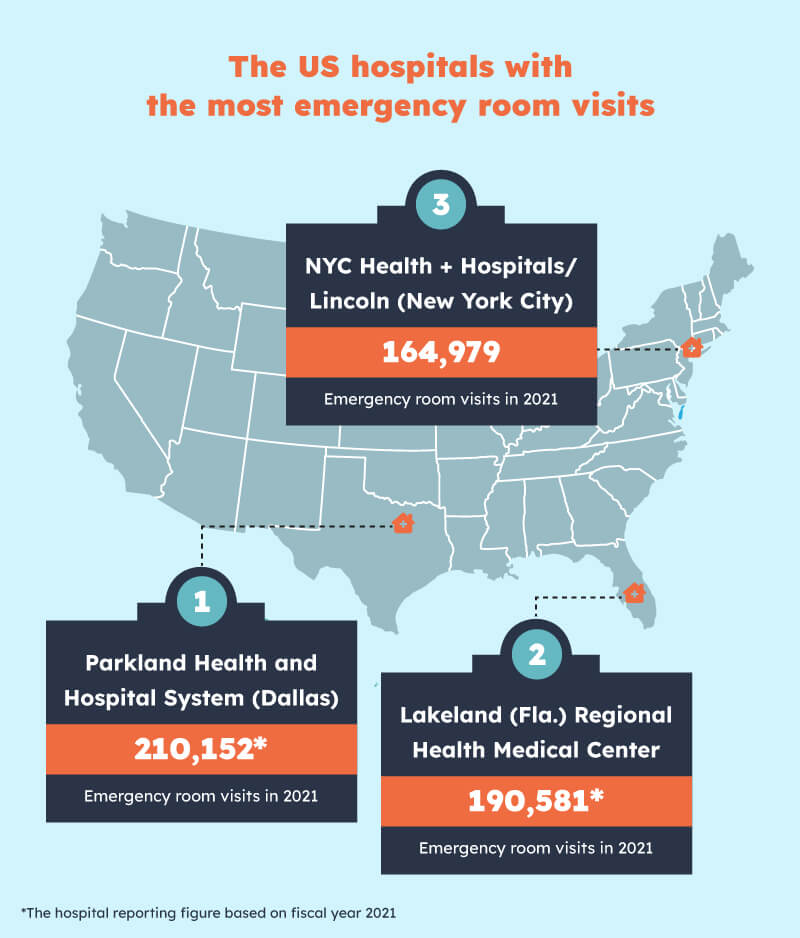
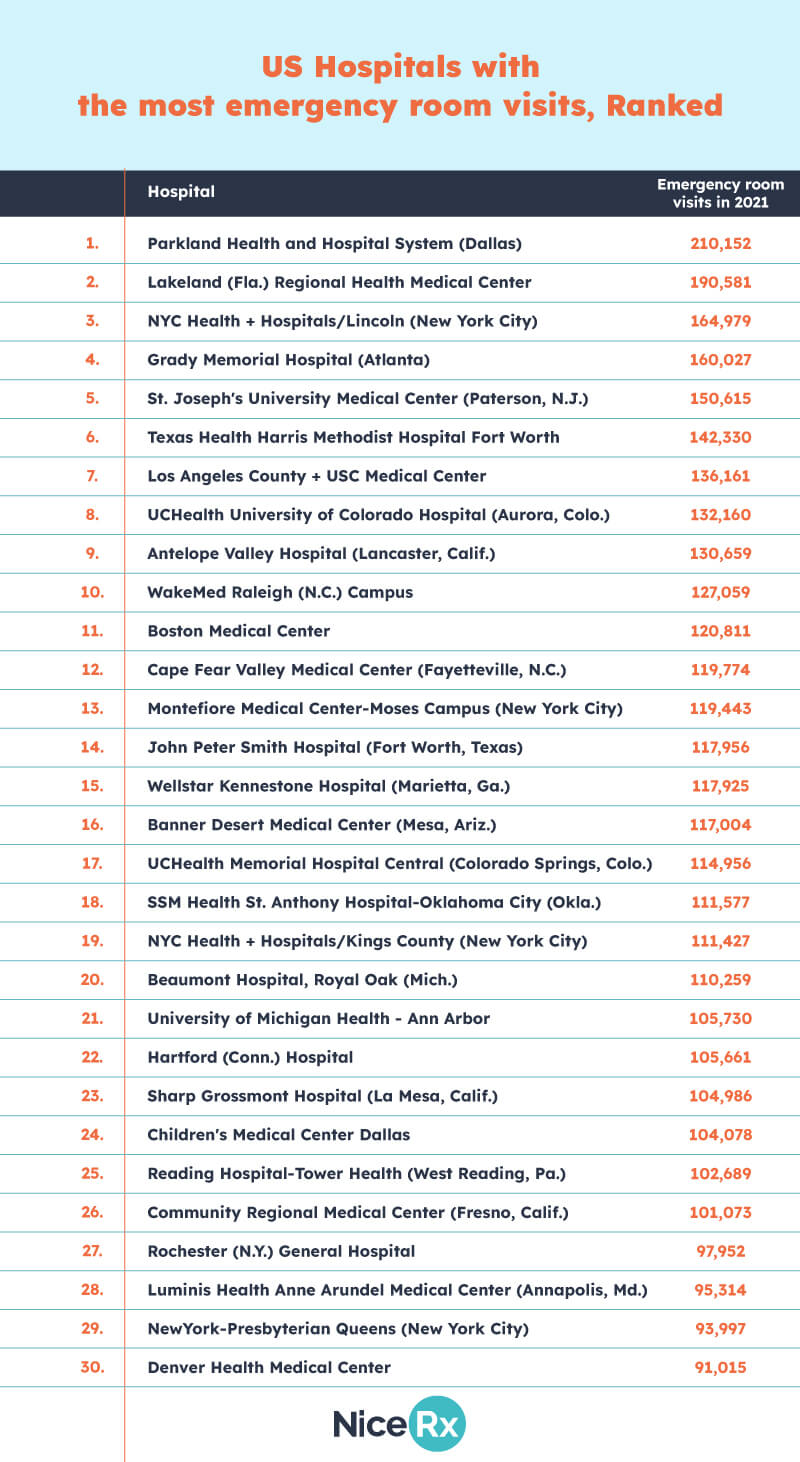
1. Parkland Health and Hospital System (Dallas)
Emergency Room Visits in 2021: 210,152*
Parkland Health and Hospital System in Dallas reported the most emergency room visits in 2021. In 2021, research revealed that hospitals in North Texas saw an expected rise in hospitalizations from the fast-spreading omicron variant of the COVID-19 virus.
In Dallas, Parkland Memorial Hospital reached a record single-day total of visits to the emergency room.
2. Lakeland (Fla.) Regional Health Medical Center
Emergency Room Visits in 2021: 190,581*
Lakeland Regional Health Medical Center in Florida had the second-highest number of emergency room visits in 2021. Lakeland Regional Health ranks as the second busiest emergency department in the nation. The hospital has the second busiest emergency department in the country, according to a report in 2022.
3. NYC Health + Hospitals/Lincoln (New York City)
Emergency Room Visits in 2021: 164,979
NYC Health + Hospitals/Lincoln had the third-highest number of emergency room visits in 2021. The hospital reported 164,979 emergency room visits in the year. Even as coronavirus cases surged in every borough, city Health Department statistics showed that residents of some neighborhoods in New York have been far more likely than others to seek hospital emergency care reporting flu-like symptoms.
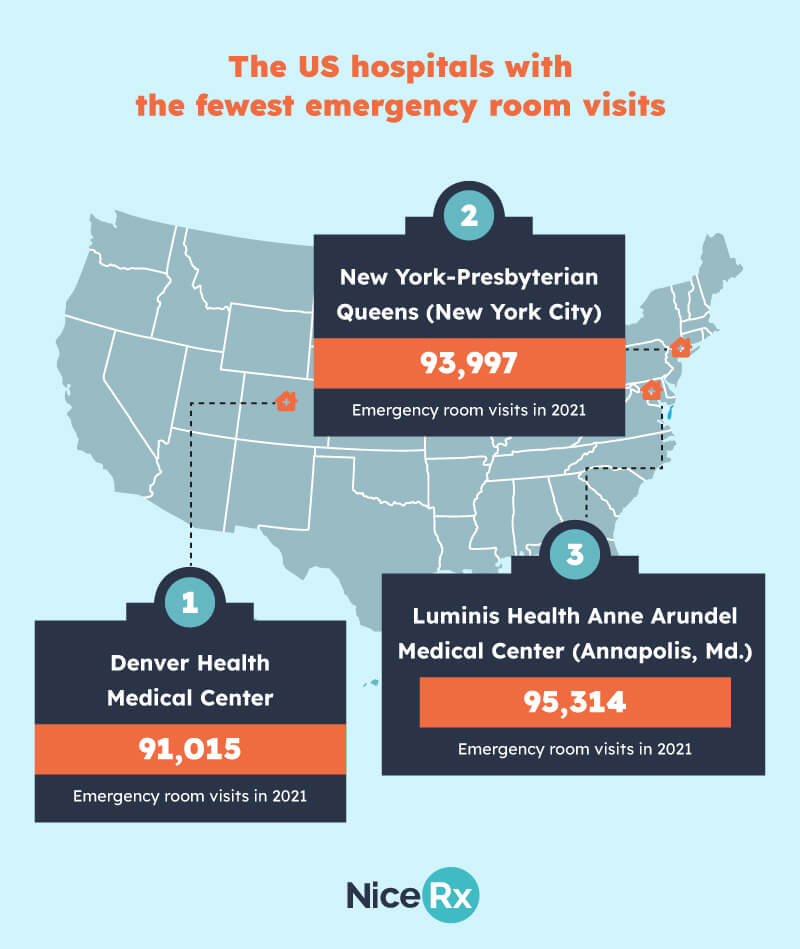
These US hospitals saw the fewest emergency room visits in 2021:
1. Denver Health Medical Center
Emergency Room Visits in 2021: 91,015
Denver Health Medical Center had the lowest number of emergency room visits in 2021, with a total of just 91,015 visits recorded. Denver is a city with a small population, which could indicate why there are a smaller number of emergency room visits.
2. New York-Presbyterian Queens (New York City)
Emergency Room Visits in 2021: 93,997
New York’s Presbyterian Queens hospital had the second-lowest number of emergency room visits in 2021, with a total of 93,997 visits recorded.
3. Luminis Health Anne Arundel Medical Center (Annapolis, Md.)
Emergency Room Visits in 2021: 95,314
Luminis Health Anne Arundel Medical Center in Annapolis, Maryland had the third-lowest number of emergency room visits in 2021. There were a total of 95,314 visits recorded. Luminis Health Anne Arundel Medical Center provides comprehensive emergency services for more than 100,000 area residents each year.
Top Tips for Injuries and Illnesses
With ER departments in high demand, at NiceRx, we wanted to share our expert tips on the injuries and illnesses which require emergency treatment and those that are less of a priority.
Sports Injuries
Sports injuries can be caused by a fall, a heavy blow or not warming up properly before exercising. They could also be caused by pushing yourself too hard or using equipment with poor technique.
Common minor injuries can be treated yourself by
- Resting the affected part of the body for the first 48 to 72 hours to prevent further damage
- Regularly applying an ice pack to the affected area during the first 48 to 72 hours, to reduce swelling
- Using painkillers, such as paracetamol or ibuprofen, to relieve pain
- If your symptoms are severe or do not improve within a few days or weeks, a doctor may be able to refer you for specialist treatment and support, such as physiotherapy.
Common Illnesses
Most people recover from minor illnesses by themselves and don’t need to be seen by a doctor. For instance, many minor illnesses, including colds and flu, are caused by a virus.
There are often things you can do to ease the symptoms whilst your body gets on with overcoming the virus. Rest and drink plenty of fluid along with paracetamol or ibuprofen to help with fever and aches. Pharmacists can also give you advice on treating minor illnesses.
Methodology
We started with HCUP’s state trends in emergency department visits by payer to find each US state’s number of emergency room visits. Any states without data available were removed. Some states had less recent data including Hawaii which only had data from 2016.
We used HCUP’s visualization of inpatient trends in covid-19 and other conditions to find each state’s number of discharges related to COVID-19 and other illnesses. Some states were removed which did not have relevant data. Some of the data was not collected in 2021, which shows in the data table.
We used Becker’s Hospital Review’s 30 hospitals with the most ER visits to find out which US hospitals had the most ER visits in 2021. The hospital reporting figures that were based on a fiscal year were marked with an asterisk.

